The neighboring countries of Peru and Bolivia make for a perfect trip together. Chalk full of some of the world’s greatest natural and historical wonders, visiting both countries is easy to do for those with limited time. While Peru gets far more yearly tourists thanks to its culinary prowess and Machu Picchu, Bolivia is vastly underrated. The Uyuni Salt Flats was the coolest thing I did on this trip!
Update 20222: The cost of the Machu Picchu entrance fee is now $45 per person.
Peru and Boliai Itinerary Summary
I had just over two weeks for my trip to both countries. Originally, I didn’t know if it would be logistically possible to visit Peru and Bolivia in two weeks and do it justice. However, with some planning and research, we saw all the main highlights on our list, which turned out to be quite extensive.
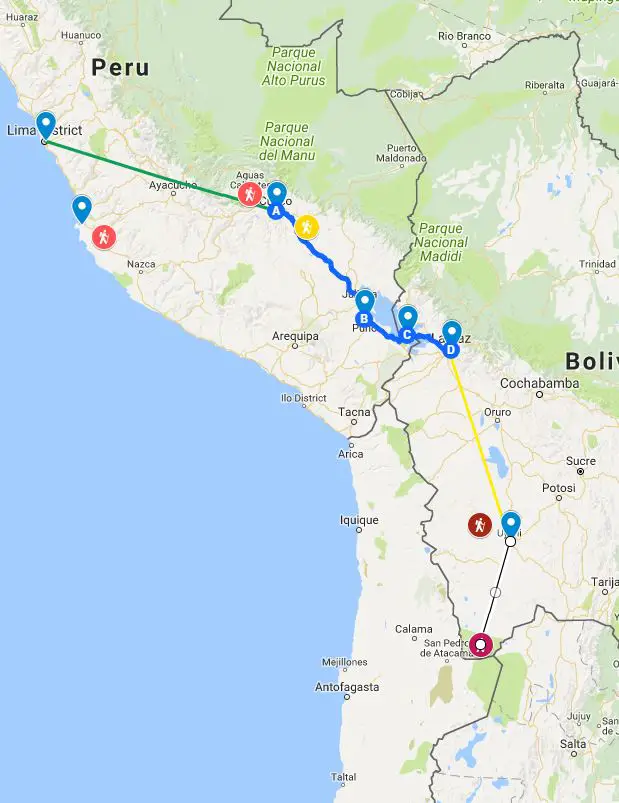
In total, our trip was 16 days and our itinerary included:
- Lima
- Paracas
- Huacachina dunes
- Cusco and the Sacred Valley
- Machu Picchu
- Rainbow Mountain of Vinicunca
- Lake Titicaca (Puno and Copacabana)
- La Paz
- Uyuni Salt Flats
If these sights are on your list and you have about two weeks for a visit, this post is for you!
Google Maps:
Day 1 to 3: Exploring Lima
We landed in Lima International Airport at 7am in the morning. After a slow Uber ride to our Airbnb in Barranco, we proceeded to immediately explore the city. Lima has such an amazing culinary scene and we spent a solid three days eating, and then eating more even if we were full.
Lima is a wonderful city steeped in history and culture, having been founded by the Spanish conquistadors in the 16th century. Its colonial architecture, such as the Plaza de Armas and the Monastery of San Francisco, is a testament to its rich past. Lima is also home to several museums, including the Larco Museum, which houses an impressive collection of pre-Columbian art, and the National Museum of Archaeology, Anthropology, and History.
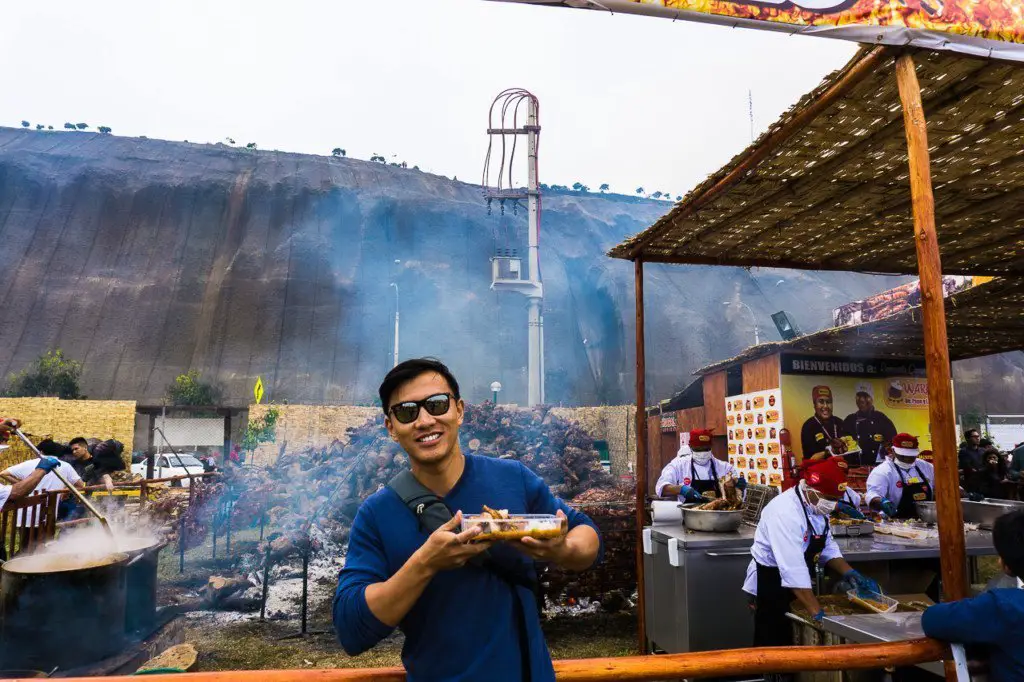
Lima has become known as the gastronomic capital of South America, and for good reason. The city boasts a thriving culinary scene that has garnered international attention in recent years. Lima is home to some of the world’s best restaurants, such as Central, Maido, and Astrid y Gaston. The city’s cuisine is a fusion of indigenous, Spanish, African, and Asian flavors, resulting in a unique and delicious culinary experience.
Countless ceviche, Lomo Saltado, and endless pisco sours were consumed. We were also in Peru during La Mistura, South America’s largest food festival featuring some of the continent’s best culinary minds. We ate here three hours before a 13 course dinner at Maido. It’s an understatement to say we ate too much in Lima!
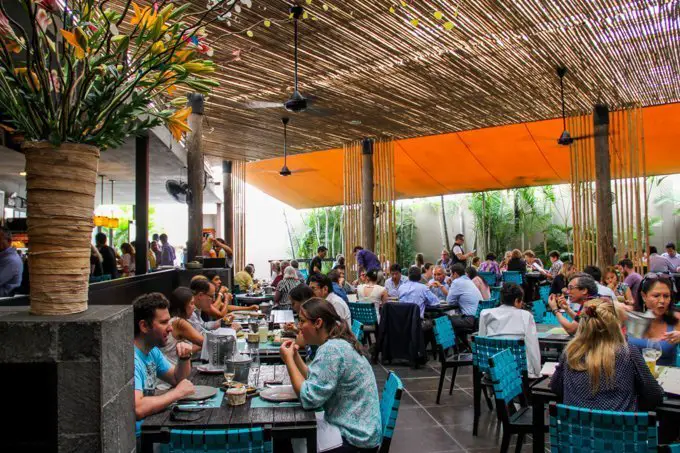
Day 4-6: Paracas
We left Lima the morning of day 4 to head south to the beautiful beaches and nature reserves of Paracas. Located only three hours south of Lima, Paracas is an easy getaway from Lima’s hustle and bustle. The ocean is calm, and the scenery is beautiful. We had an AMAZING stay at the Luxury Collection Paracas Hotel for a very reasonable price where we had the most amazing ceviche ever. Isla Ballestas, dubbed the poor man’s Galapagos is home to millions of birds and was great visit.

In addition, the Tacama winery and sand-boarding on the incredibly beautiful dunes of Huacachina made for great day trips.
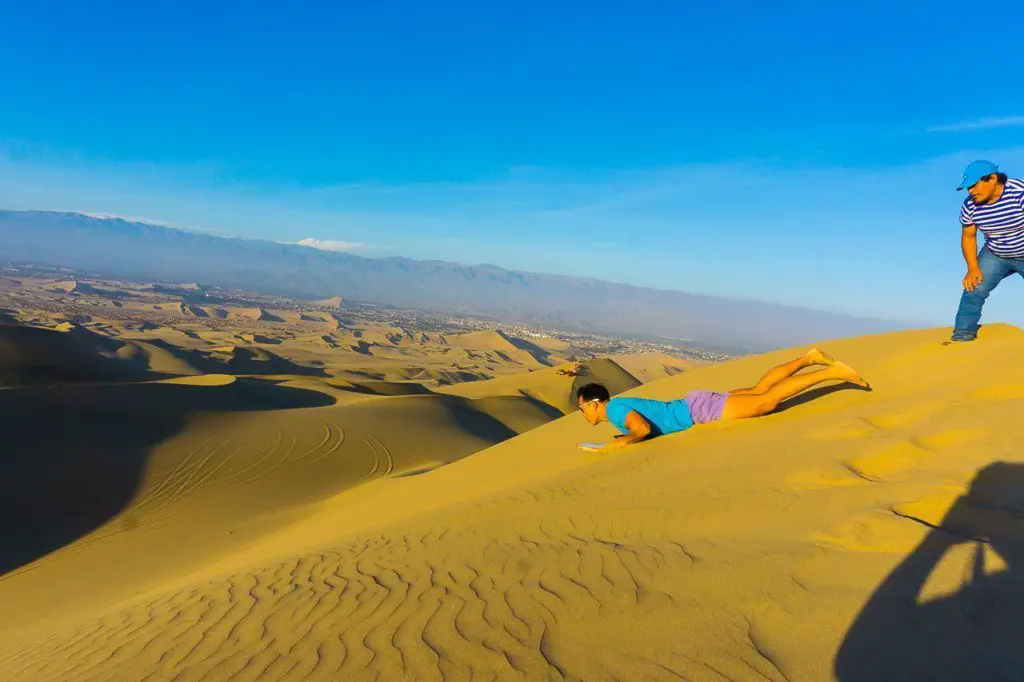
Day 7-8: Machu Picchu
We took a bus early in the morning back to Lima to catch out flight from Lima to Cusco. Upon landing, I immediately felt the effects of altitude sickness as Cusco’s altitude is at 3,300m (11,000 feet). We took a taxi straight to our guesthouse in Ollantaytambo in the Sacred Valley. The Sacred Valley is almost 1000m lower than Cusco and allowed me to acclimate to the altitude easier, ultimately saving me from feeling the full effects of altitude sickness.
No trip to Peru is complete without a visit to one of the new wonders of the world, Machu Picchu. Although it appears the whole world has visited Machu Picchu, being there in person made me quickly forget its commercialization as I soaked in the views from the top of Machu Picchu Mountain. After a long day of hiking, we returned back to Aguas Caliente and drank copious amounts of Pisco sours after meeting another pair of travelers. We ended up missing our train and didn’t get back to Ollantaytambo until late in the night.
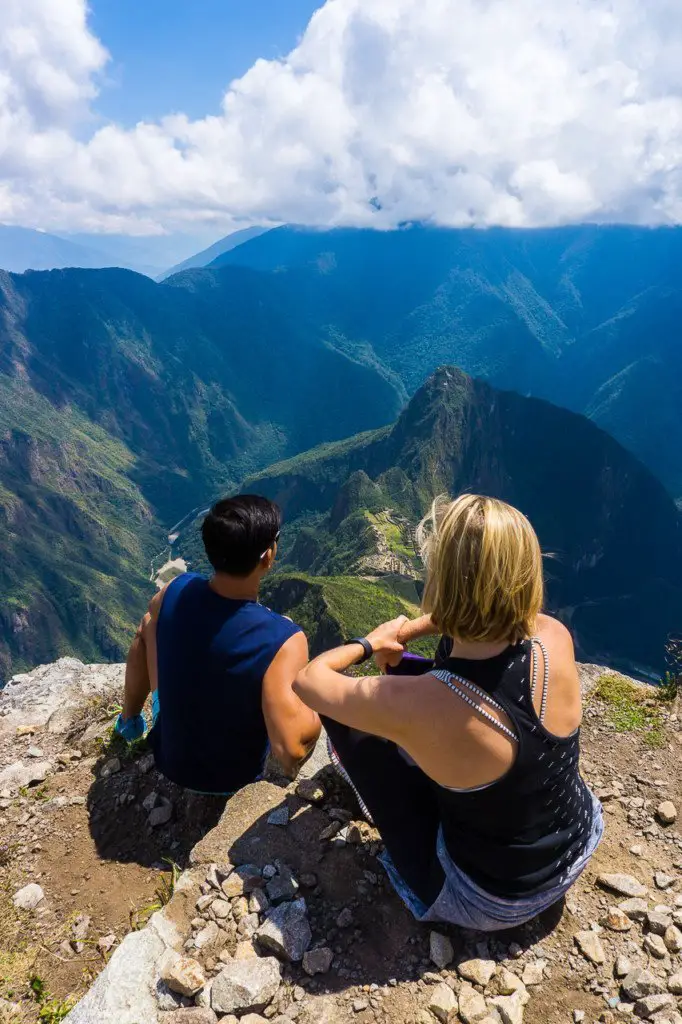
Entering Machu Picchu
This was it. Finally, we were here. After seeing countless photos, videos, and documentaries on this place, it was finally my turn.
Our path was still shrouded in the morning clouds but this is almost every day. Away we went. The ruins are right next to the entrance so it wasn’t long before I reached the fabled ruins of Machu Picchu. Ten minutes later and we were already at the famous viewpoint area of Machu Picchu where we could gaze upon one of the seven new wonders of the world. Llamas were grazing all around us (yes there are llamas all over Macchu Picchu, and it felt a bit surreal.
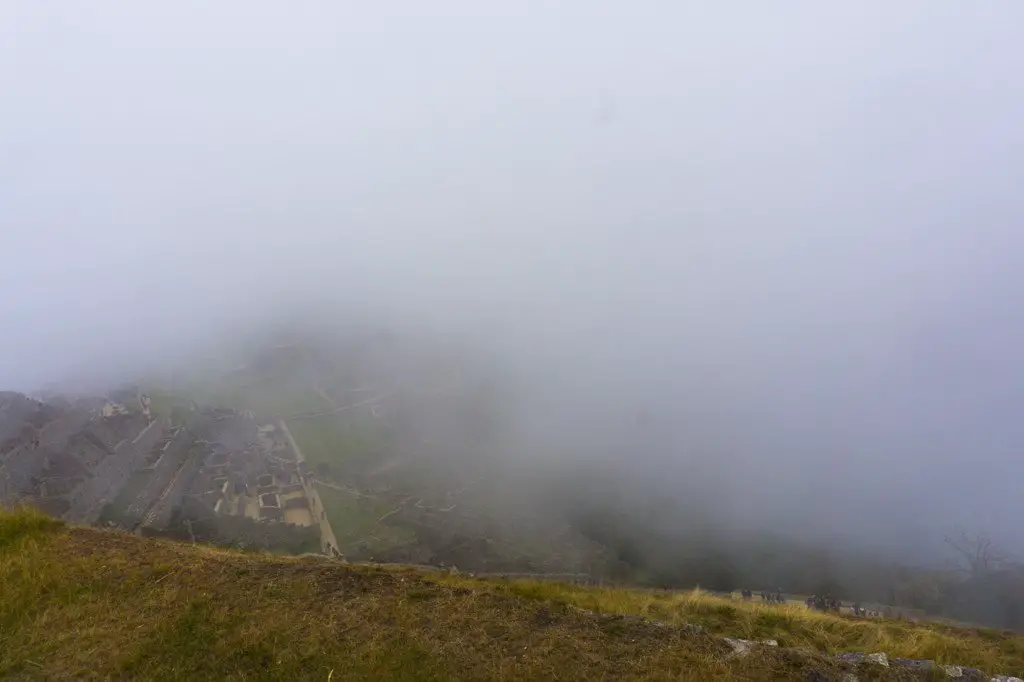
However, it was completely covered in clouds in the morning and I could not see a damn thing. I met people that raved about coming to Machu Picchu for the sunrise but they must have been real lucky because other people have told me Machu Picchu is almost always covered in clouds in the morning so I’m not sure how amazing a sunrise experience would be.
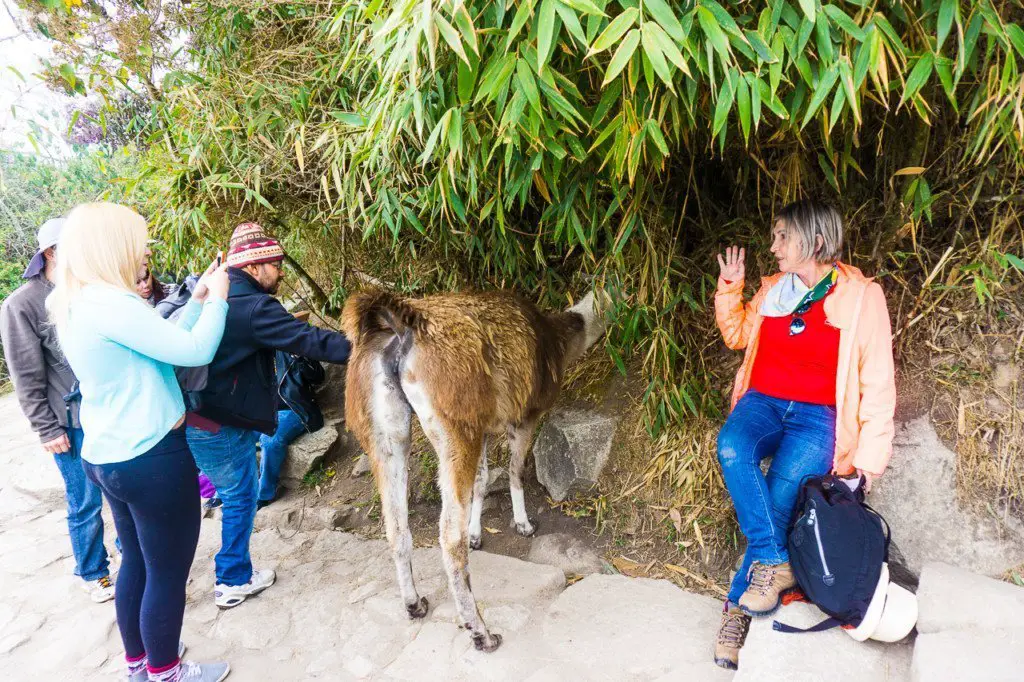
Seeing as we couldn’t see anything (around 8:30am), we figured we would start our hike up Machu Picchu mountain (Montaña Picchu). At 8:30am, it was already getting warmer so I changed into shorts and a tshirt knowing that this I would thank myself once I started hiking.
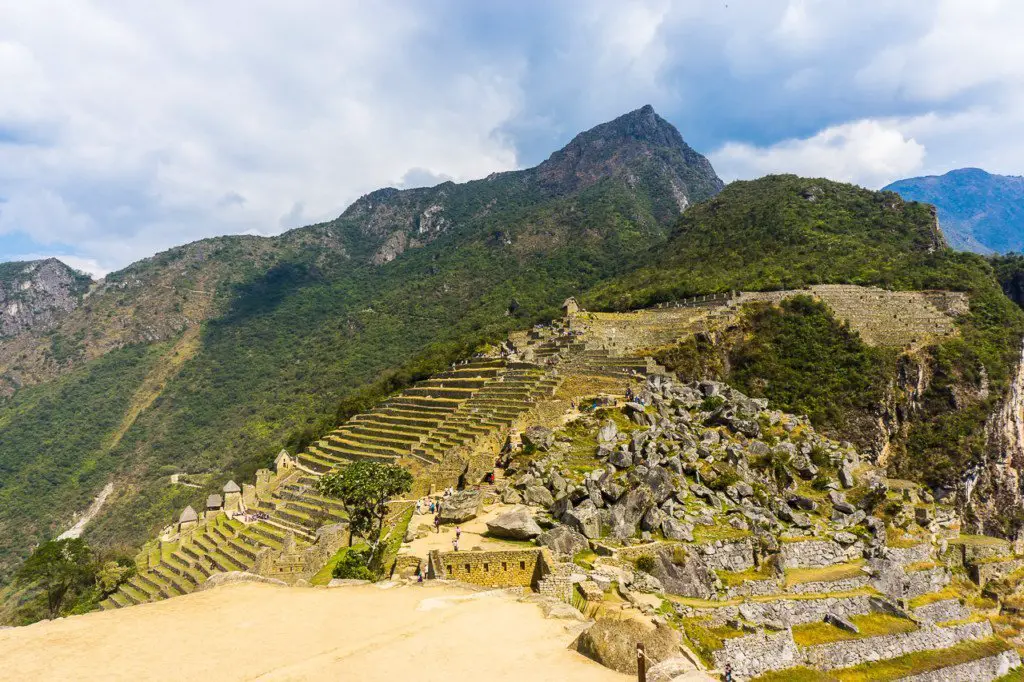
Hiking Montaña Picchu (Machu Picchu Mountain)
Montaña Picchu is no joke. This is a difficult hike to say the least. It’s a 800m climb to the top and is very steep. Being at 2500m already, the hike was even more difficult as we were constantly gasping for whatever thin air we were already breathing. We took numerous breaks to recover and soak in the views, or at least that’s what I told myself.
As we climbed higher, the clouds were beginning to dissipate and we could see more of the surrounding landscape, occasionally gazing at Machu Picchu as it became more visible. Overall, our hike was just under 1 hour and when we reached the summit, it was a sense of accomplishment and relief.
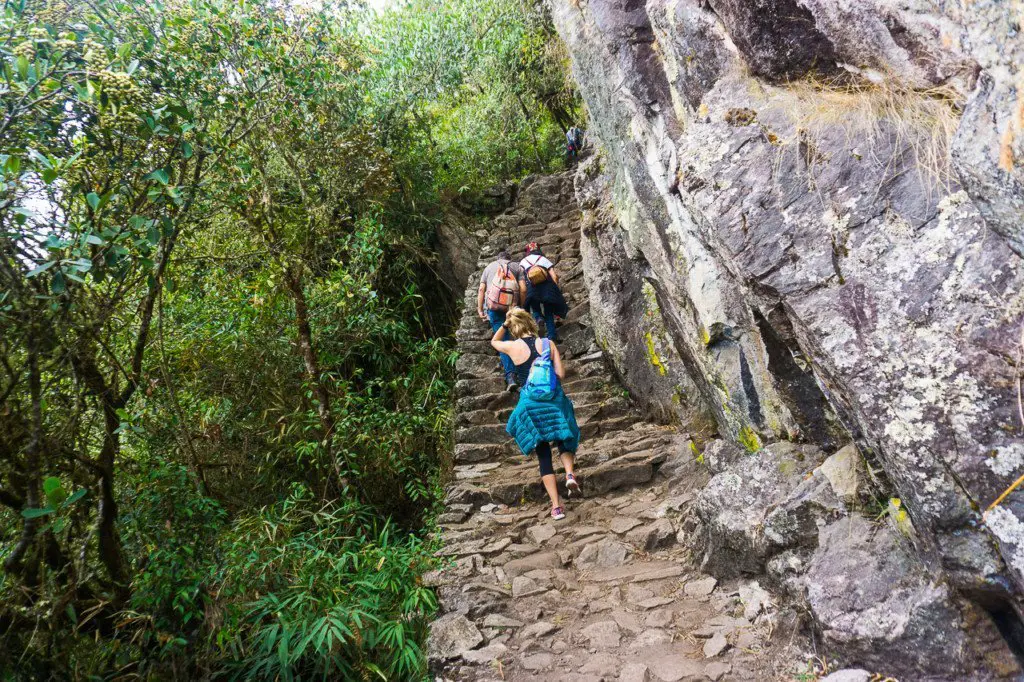
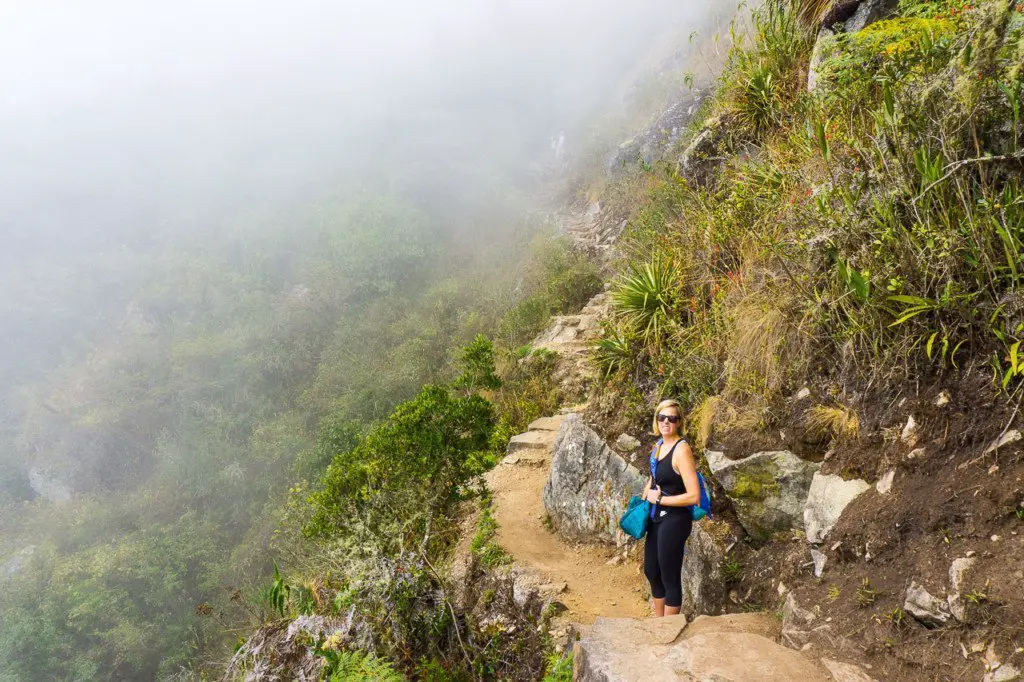
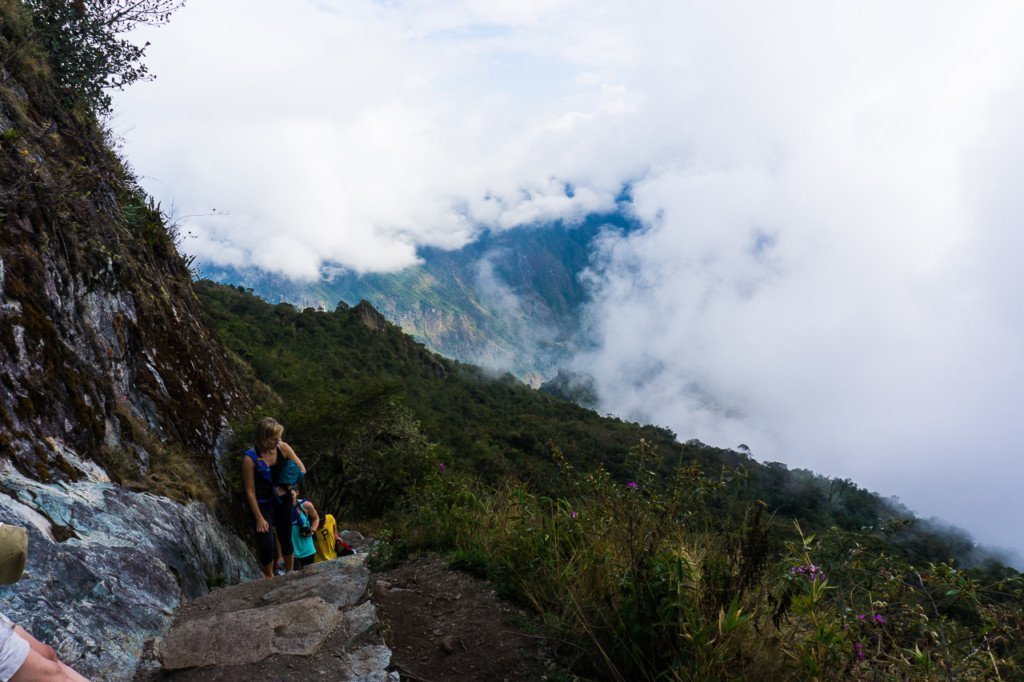
Reaching the summit of Machu Picchu
The views from the top are incredible. It was still relatively early so there weren’t many people at the peak and the clouds were still covering Machu Picchu. When they finally burned off, the views were absolutely stunning. The ruins are small from so high up but you get a more aerial view of Machu Picchu and the Huayna Picchu mountain in the distant.


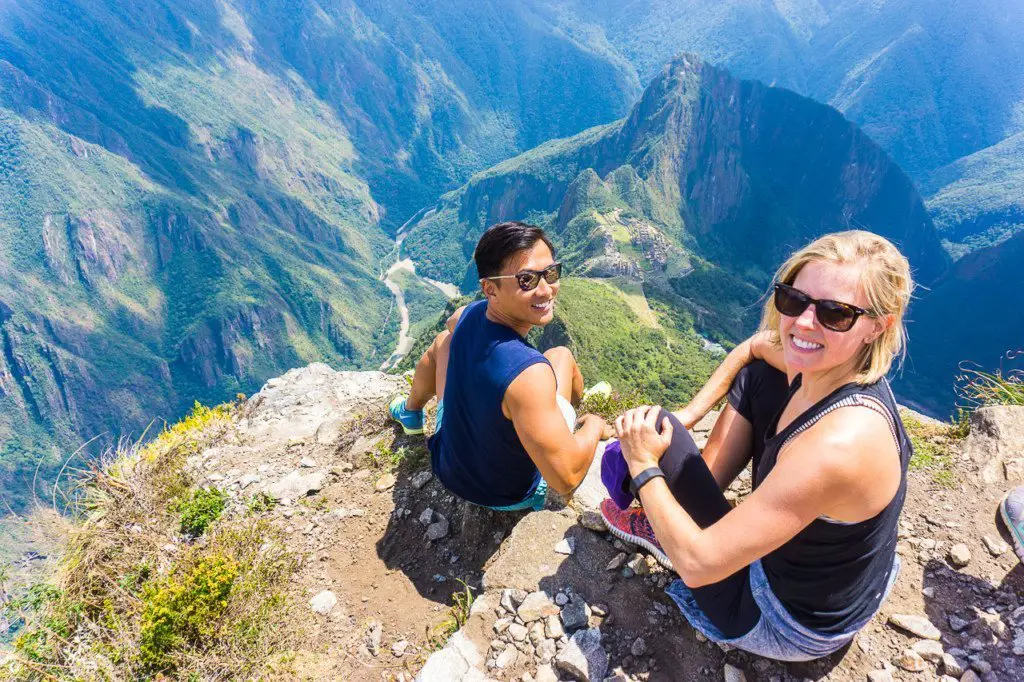
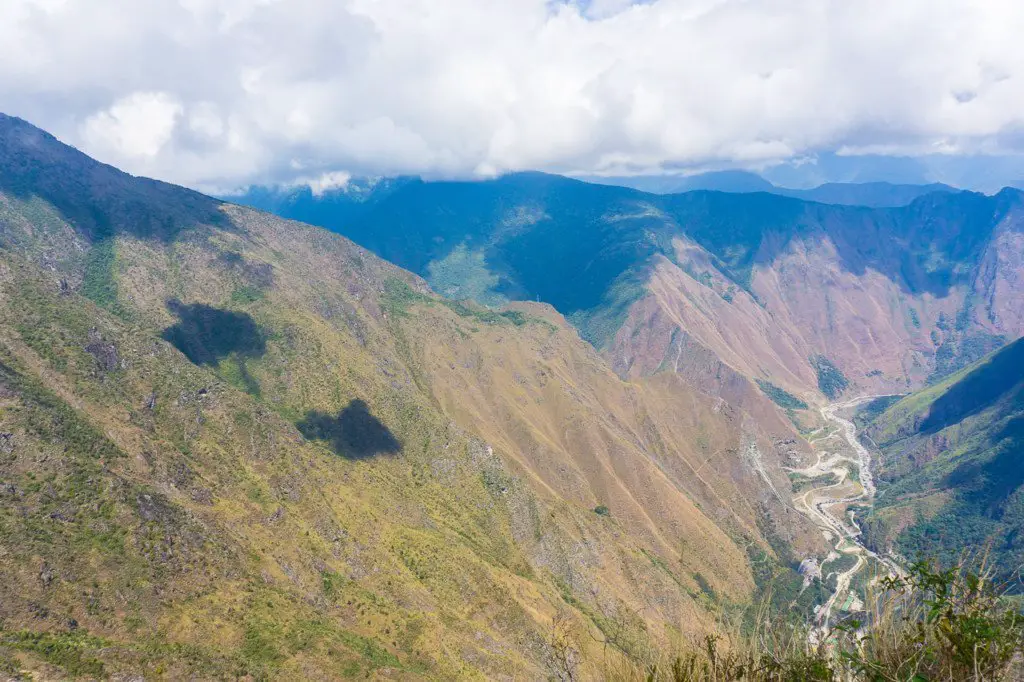
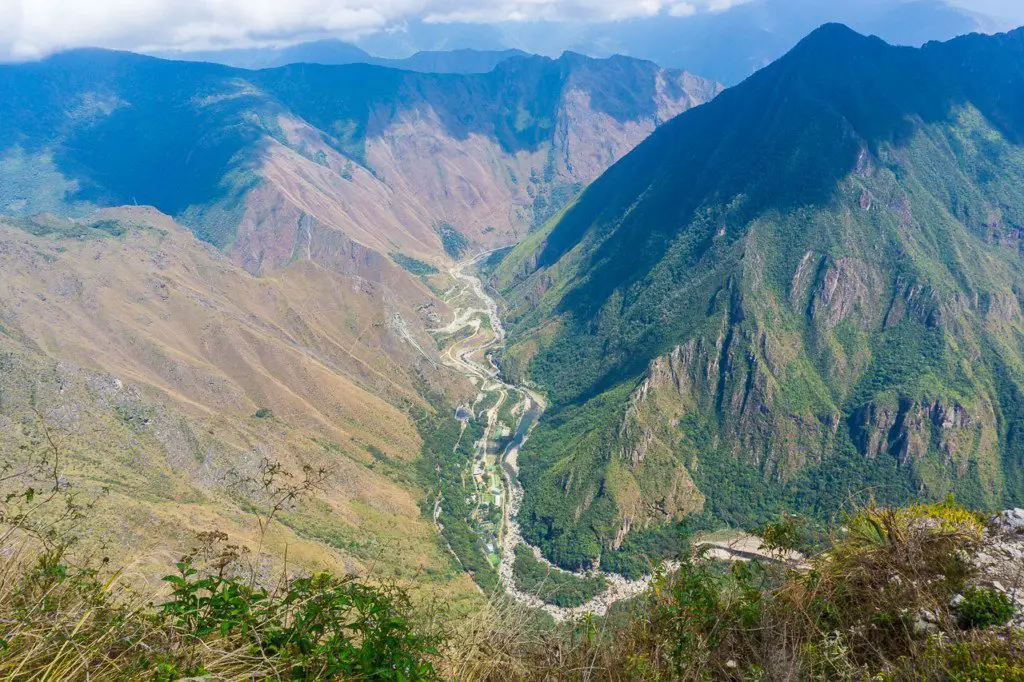



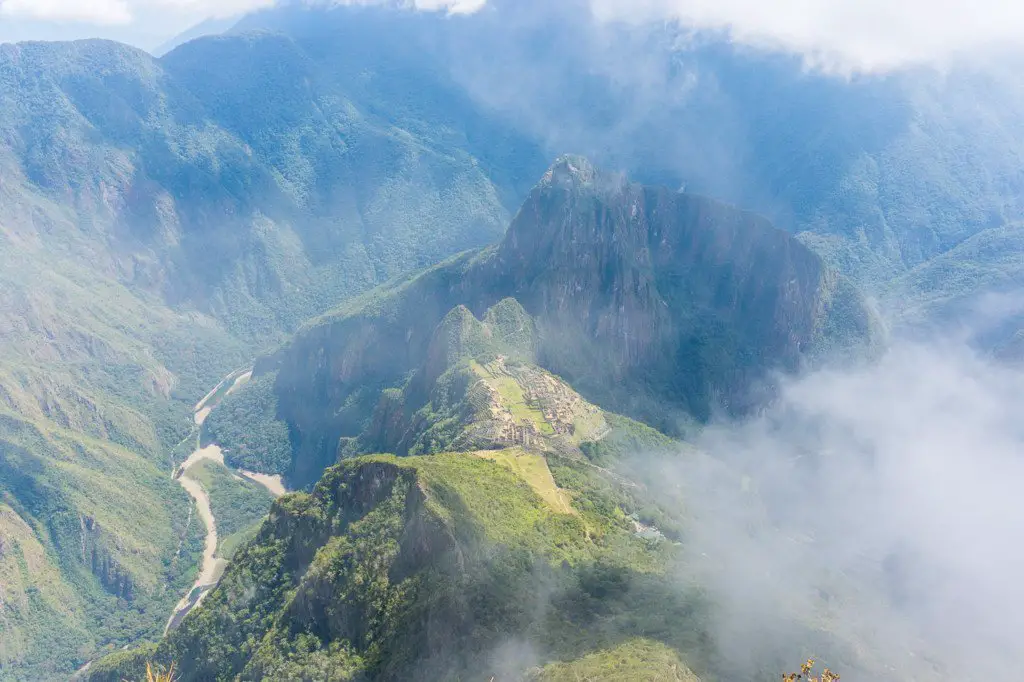
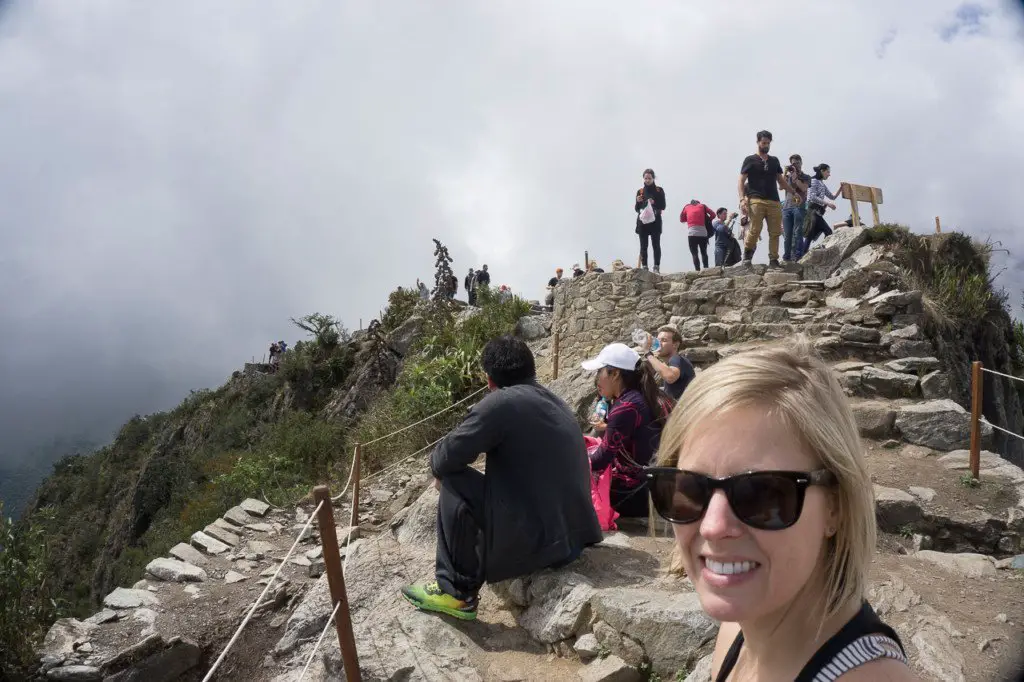
The best views and photo opportunities go to those that are the most daring. We climbed over the rope fence and sat at the very edge. It’s a sheer drop from the edge and too much sudden movement or irresponsible selfie taking will lead to certain death. In fact, a few weeks prior to our visit, a German tourist was taking photos in the same area but slipped and fell to their death.

We spent at least an hour sitting at the top of Montaña Picchu. The views never got old and I had some good talks with the other travelers sitting on the edge of death with me.
Day 9-11: Sacred Valley, Cusco, and Rainbow Mountain
After an amazing visit to Machu Picchu, we visited the main sights within the Sacred Valley: Ollantaytambo, Pisac, Moray, Chinchero and ended the day in Cusco. Cusco is Peru’s second largest city and could not be more different from Lima. After a nice night’s rest, we toured around Cusco, visiting the main sites for a day. We stayed at another wonderful guesthouse/Airbnb in the old town with fantastic views of the city and mountains.

The next day, we took a day trip to the beautiful Rainbow Mountains in Vinicunca. This is a newer tour and gaining popularity quickly. Pictures don’t do it justice!

Cost of the Rainbow Mountain Tour
The cost of this tour is around 100-120 soles per person, or about $30-$35. Anything more than this is a rip off. Don’t do it. For example, searching for Rainbow mountain tours on Google will take you to nice websites that might charge you $100! Peru is a cheap place and $100 is a crazy price to pay for a group day tour. Also, feel free to bargain with the travel agents. I met someone that ended up paying 80 soles for the tour.
There are multiple day tours, 2 day tours, and the ever popular day tour which I did. As for the day tour (and likely for the multiple day tours), the itinerary is all the same. Many of the tour agencies like to boast about how their agency does something different or provides something extra, but it’s all for show. All tour agencies pick up their guests around 3am in the morning, provide breakfast and lunch, and of course a guide for the hike to the top.
Dressing for the Rainbow Mountain
Cusco is around 3400m, but the base of Vinicunca is even higher at 4200m. The mornings were brisk and chilly. Wearing layers is key to this hike as the weather is so variable. As the day progresses, it can be pleasantly warm in the sun, and surprisingly cold in the shade. The hike is strenuous enough however, that you’ll likely become warmer regardless.
The wind, especially near the peak, can be crazy strong. While I wanted to enjoy the views of the Rainbow Mountain at the top, the hurricane force winds made the stop short lived.
The Rainbow Mountain Hike
The day began very early. Our alarms went off at 2:45am and although we attempted to go to sleep at 7pm, a dinner and drinks with two travelers we met at Machu Picchu assured that we wouldn’t get to sleep until at least 10pm. Running on 4 hours of sleep, we grabbed our stuff for the day and headed outside to wait for our transportation. The pick up window is 3am to 3:30am. We saw many vans come and go, all likely heading to pick up other Rainbow Mountain day trippers. Ours finally came just after 3:30am.
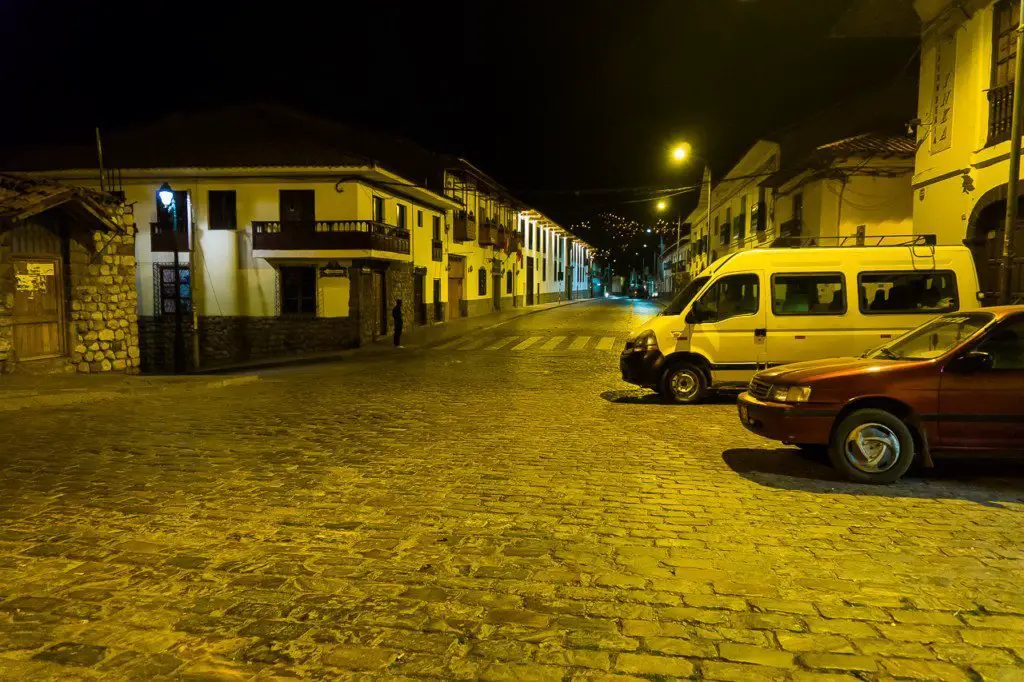
We picked up a few more travelers until the van was full with about 15 people. As it was early, and everyone was equally as passed out as me, no one said anything for the entire 3 hour drive to the base of Vinicunca.
After attempting to sleep in our way too small van, we finally arrived at the base of the mountain. I hadn’t seen much of the scenery along the way as it was too dark but as as soon as I stepped out, it’s tough to not notice the incredible landscape in front of me. Rolling terraced mountains dotted the landscape, and the grandiose icy mountain of Asangate was looking me in the eye.
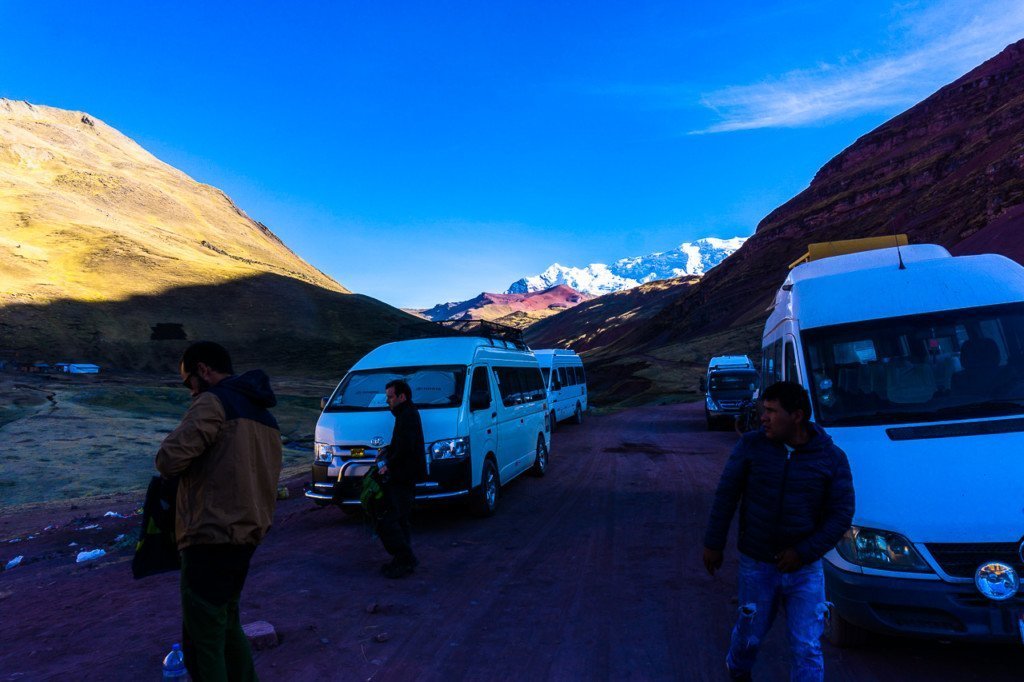
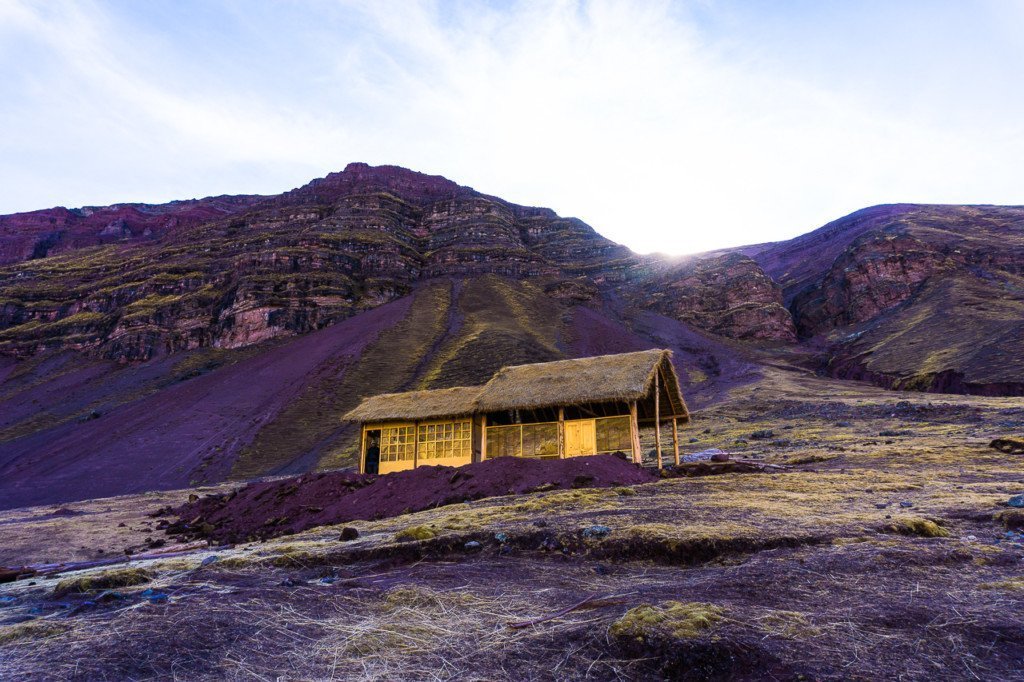
We gathered our belongings and headed into a small wooden house where we had our breakfast over a big wooden table. Eggs, fruit, porridge, and coffee were on the menu for the morning. Coffee seemed to give the entire group life as we were all still awaking from our zombie states, and we finally had time to get to know each other

Once breakfast was finished, we finally began our hike around 9am. Our guide gives us a short briefing of what to expect, and then walked 10 minutes to our meeting point where we converged with the other ten vans of people. It’s at this meeting point where those that want to hire a horse for the day can do so. We hired a horse (comes with a guy) for the two of us which was a steal at 70 soles.

I didn’t find the hiking itself to be difficult as the climbs are nowhere near as steep as Machu Picchu Mountain. However, at such high elevation (4500m+), the air is so thin that I was constantly gasping for breath. Near the top, I couldn’t take more than 10 steps without stopping for air.
I would consider myself in shape too, but it didn’t matter as I just wasn’t used to the extreme elevation. If anything, even if you wanted to hike the entire thing, having the option of the horse to fall back on is clutch. Also, it was amazing to have the horse to carry our bags the entire way. That alone was worth the 70 soles to us.

We alternated usage of the horse, mostly using it for climbing. Initially, I felt guilty and untrue to my backpacker ways for renting the horse. I can safely say that backpacker ways be damned, thank God I got one. If you’re in doubt, just do it and thank yourself later!
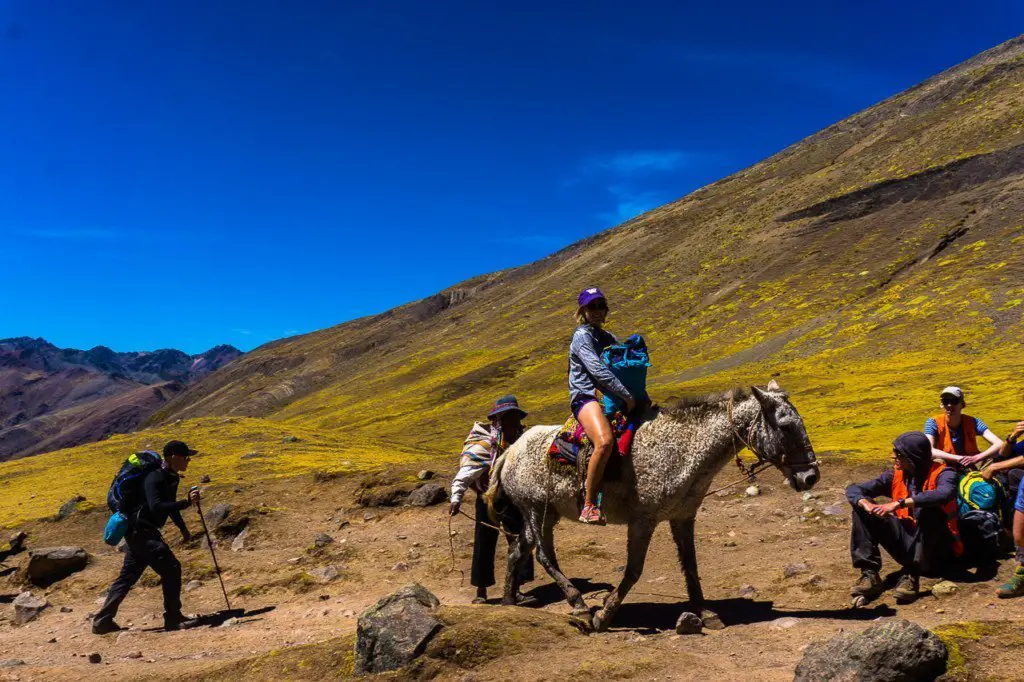
The scenery is absolutely. breathtaking. We passed through vibrant green valleys with red mountains all around us. Llamas and Alpaca dotted the landscape, grazing on the grass fields of the local villages that owned them. Asangate Mountain, covered in snow and soaring 6000m into the sky, made the scenery that much more dramatic. These amazingly furry and cute sheep dogs followed us the entire way as well.

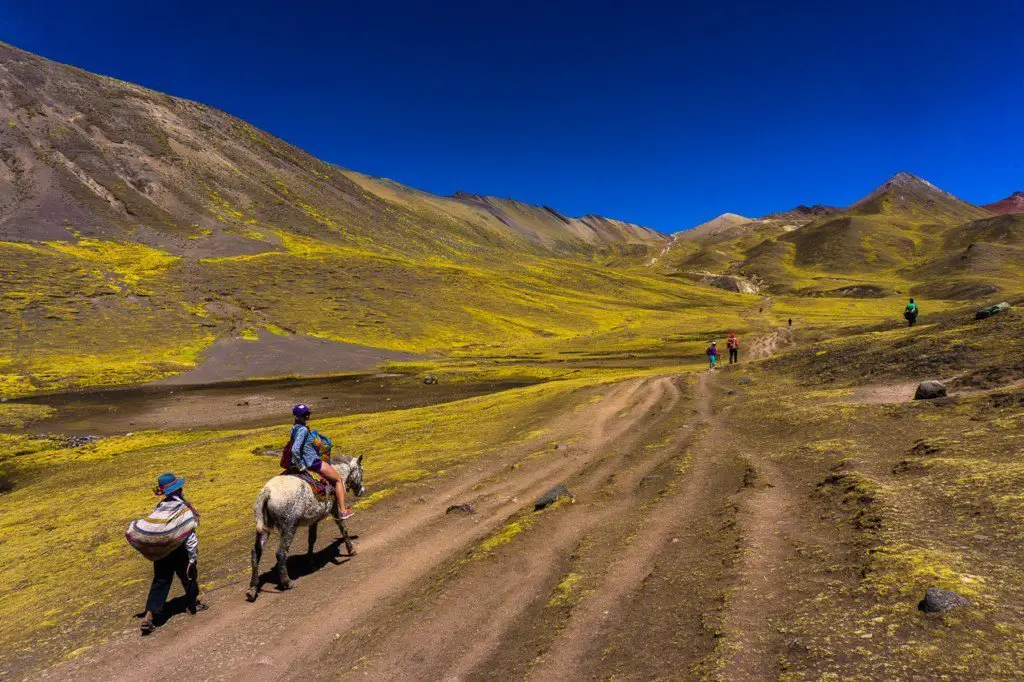
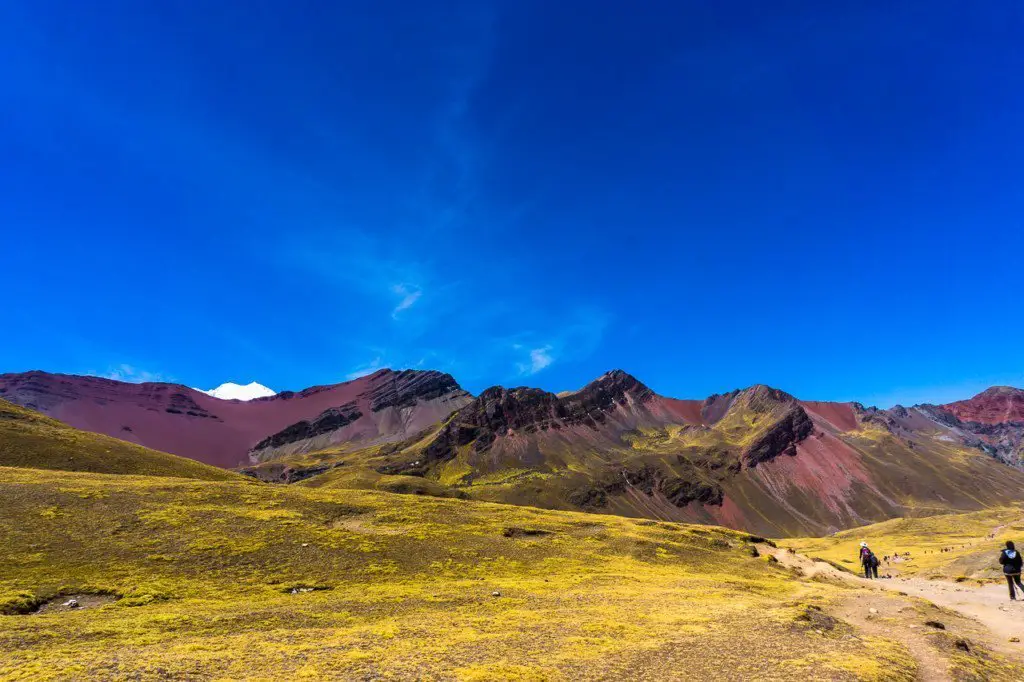

The hike to the top took around 3 hours. Our guide advised everyone to take it at their own pace and everyone was feeling the effects of the extreme altitude. Getting that horse was the best decision of my life and I couldn’t care less about the mountain beating me. The peak is 5000m! I can live with it. Backpackers can be freaks for punishment, but on this day I did not want any part of it.
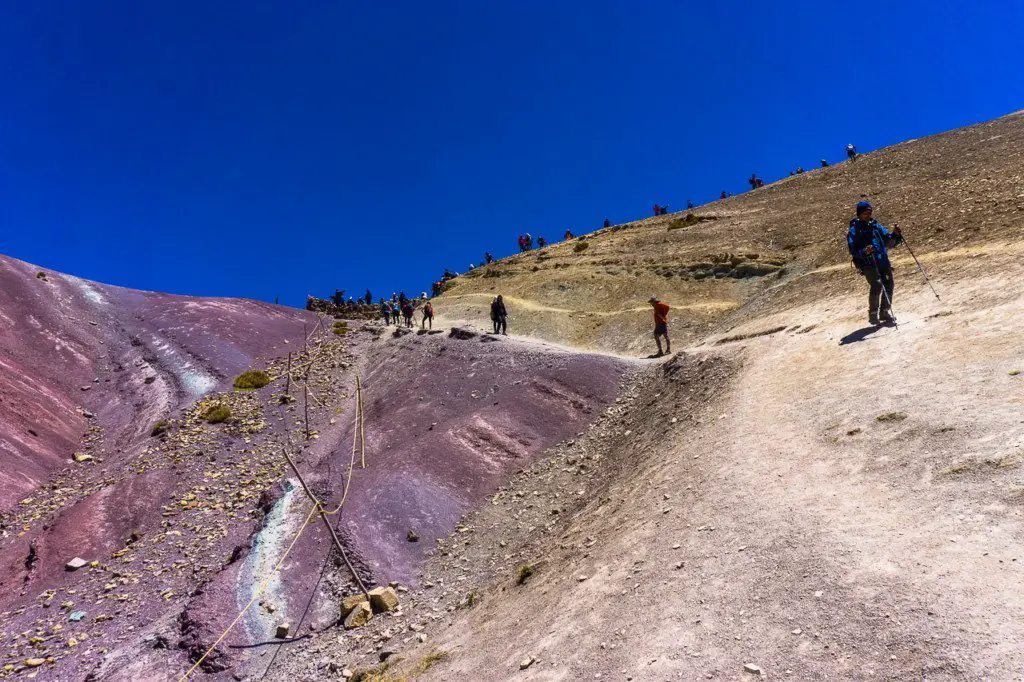
When we finally reached the top, it was a huge sigh of relief. That crazy hike was over, and we could finally stop to enjoy the views. It was as amazing as the pictures looked. What the pictures don’t capture is the crazy views of all the surrounding mountains. We stopped here for almost an hour to just admire this stunning piece of nature. The vivid mountains are the result of mineral deposits and red sandstone from over 24 million years ago. Layers formed on top of one another, creating the colorful patterns of rock strata. For example, iron contributes to the red, and copper is the light green.

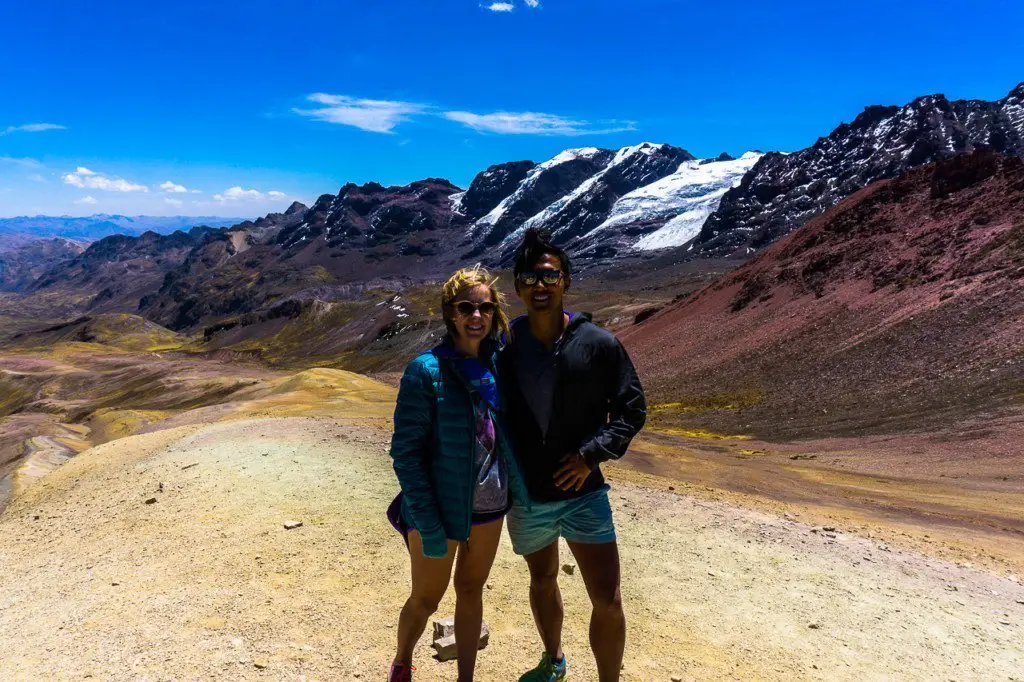
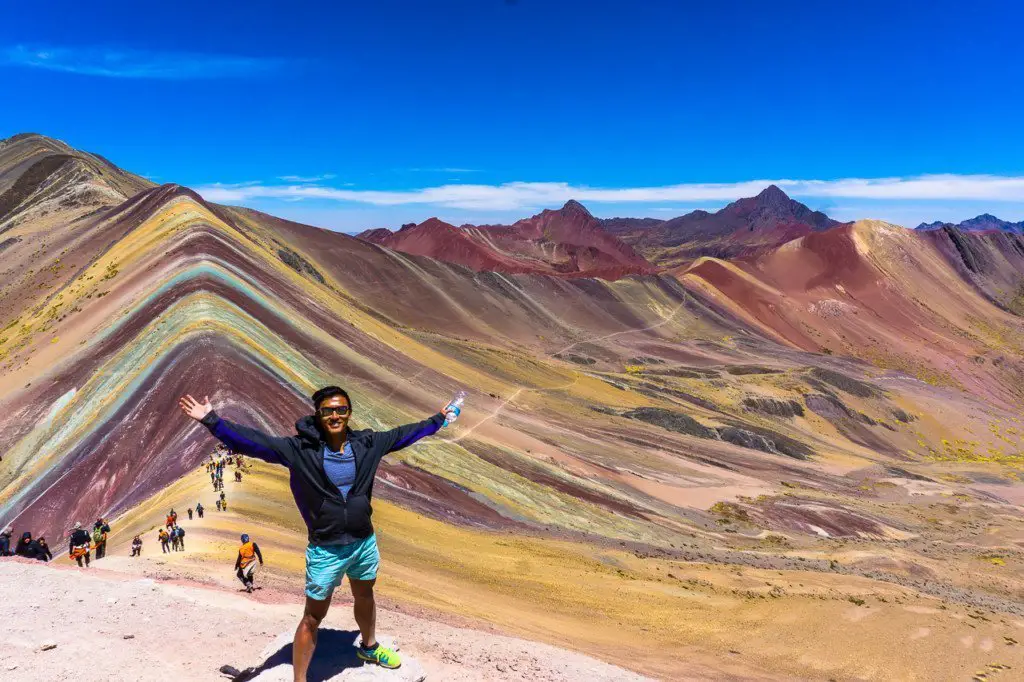
The wind was crazy strong at the top but that did not stop us from taking our photos. There really is no way to take a bad photo here. Just have your back (or front) pointed towards the mountain and shoot. I wish we could have stayed here all day but the winds got stronger by the minute and we needed to head back so we could make it back to Cusco on time.

We were back at the base camp in two hours (around 3pm at this point). We had lunch in the same wooden house as breakfast. Lunch was actually delicious. They made us a huge spread of lomo saltado, sopa de quinoa, pollo chicharron, and pasta. Great way to end an amazing day.
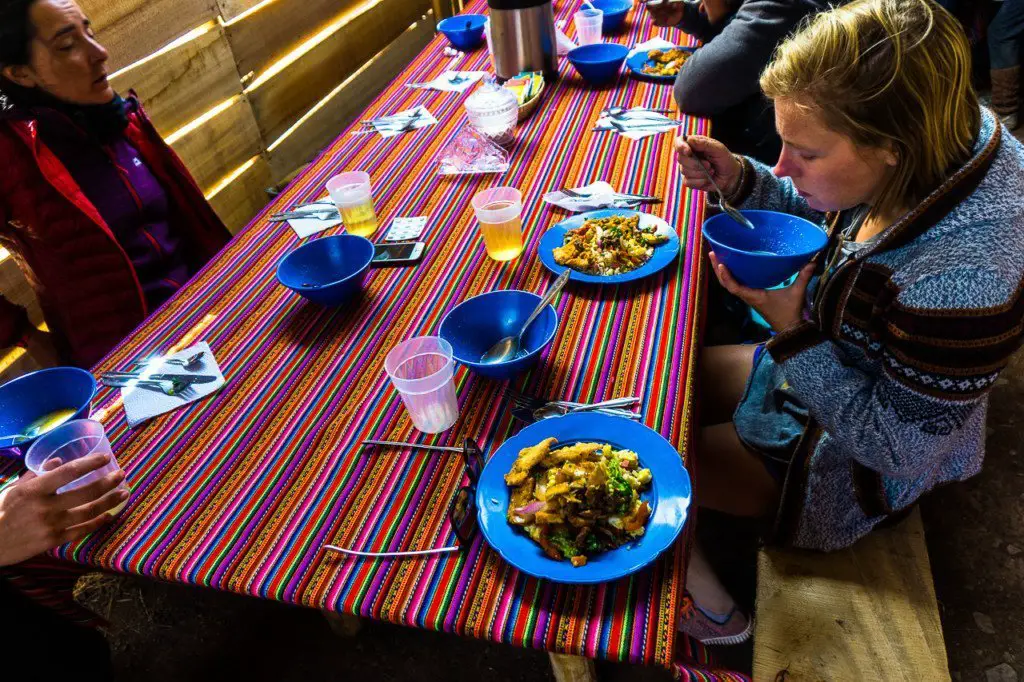
The beauty of this mountain won’t soon be forgotten. We headed back in our tiny vans, arriving at Plaza de Armas in Cusco around 7pm. Just in time for some pisco sours!
Day 11-12: Cusco to Lake Titicaca to La Paz
There are regular flights from Cusco to La Paz, but we wanted to also visit Lake Titicaca. We took an overnight bus with Bolivia Hop that left from Cusco. We traveled overnight, stopping in Puno in the morning, crossing over the Peru-Bolivia border to Copacabana (a huge hassle for Americans), and arriving in La Paz at 10pm. The bus made long enough stops in Puno and Copacabana to allow for quick tours of Lake Titicaca. This is the one part of my itinerary that I wish I had more timeas Lake Titicaca was stunning.

Day 13-15: Uyuni Salt Flat Tour
After a short night sleep in La Paz, we took a 7:30am plane from La Paz to Uyuni. Our 3 day, 2 night Salt Flat tour started that morning at 10am. This might seem hectic to take a plane and go straight to a three day tour, but it is quite common from what all the tour operators in Uyuni told me.
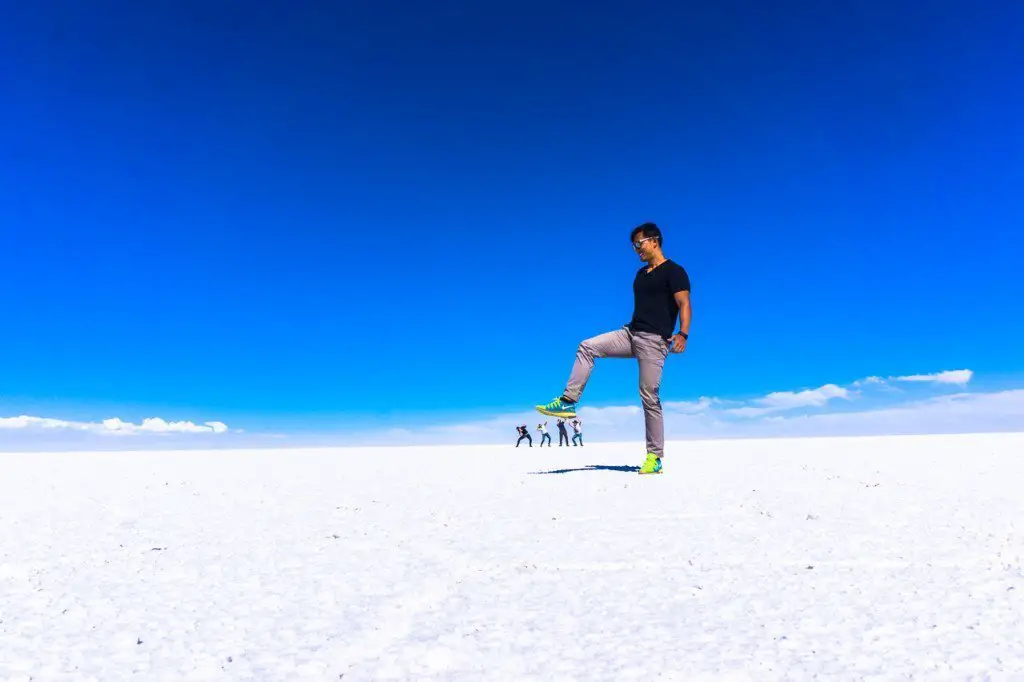
The salt flats was probably my favorite part of the trip. The landscapes were so unique and picturesque, with one wow moment after the other. I felt like I was on another planet on a regular basis.

These are the largest salt flats in the world by far, at the size of the Netherlands.

We stopped for lunch at a hotel completely made from salt. Lunch was alpaca steaks and quinoa. As far as tour food goes, this actually wasn’t that bad. The steak was totally overcooked but it was still doable.

After lunch, we made our way deeper into the salt flats to take those iconic depth and perception photos that have made the salt flats world famous. The Uyuni salt flats are incredible. Honeycomb shaped salt as far as the eyes can see, so white and so bright that your eyes are forced to squint. The salt crystals are extra salty too so just in case you forgot to bring salt with you on the trip!
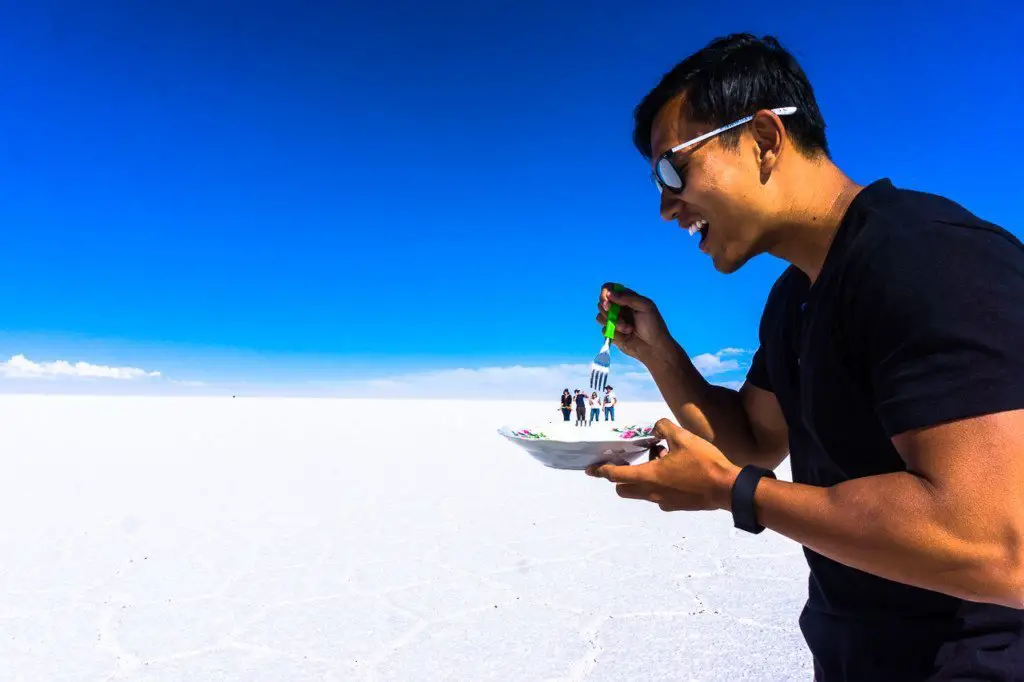
We stopped for at least 40 minutes to take our photos. We had a lot of fun getting our optical illusion shots. To take the best photos, it all depends on the pedigree of the person taking photos. Thankfully, your driver/guide will have done this hundreds of times and know how to get the best pictures.


I could have stayed here for another hour but we had an itinerary to follow and the next spot was even more amazing.


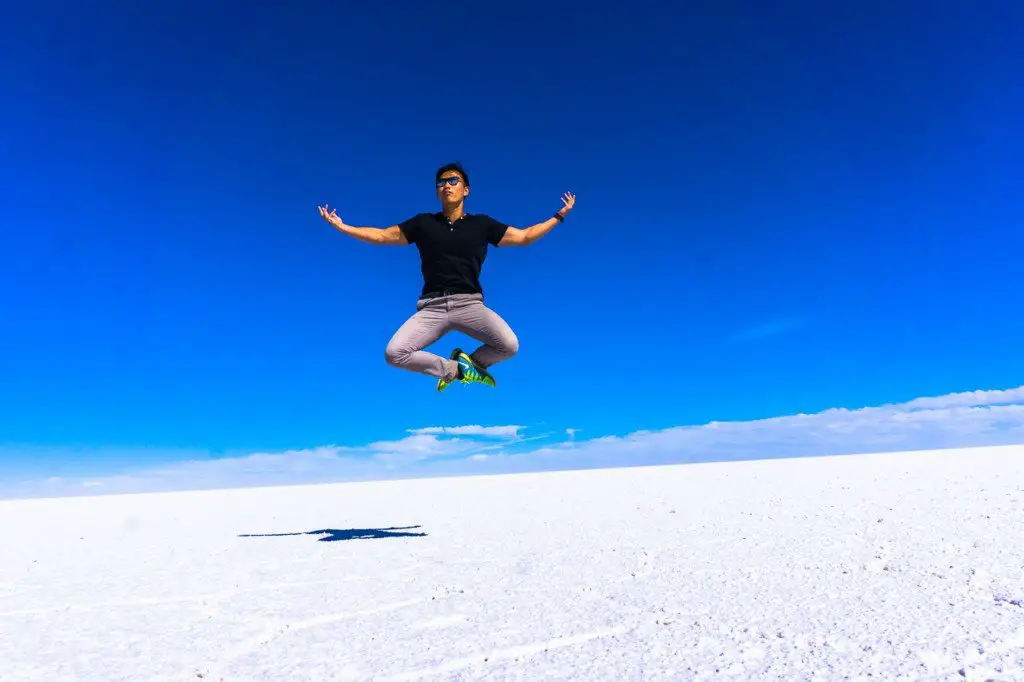

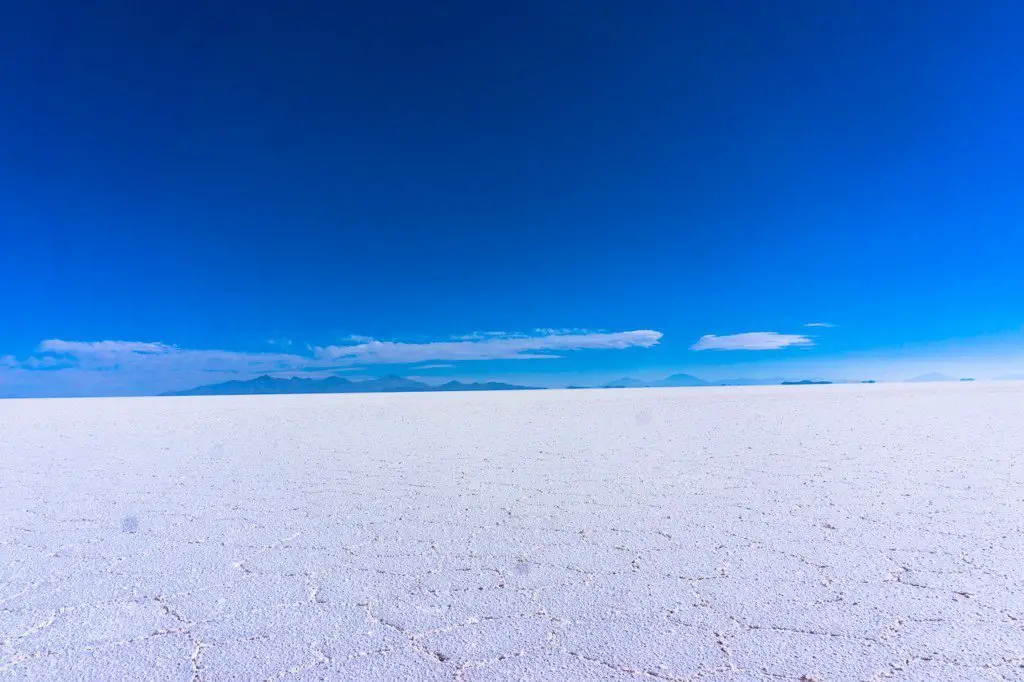
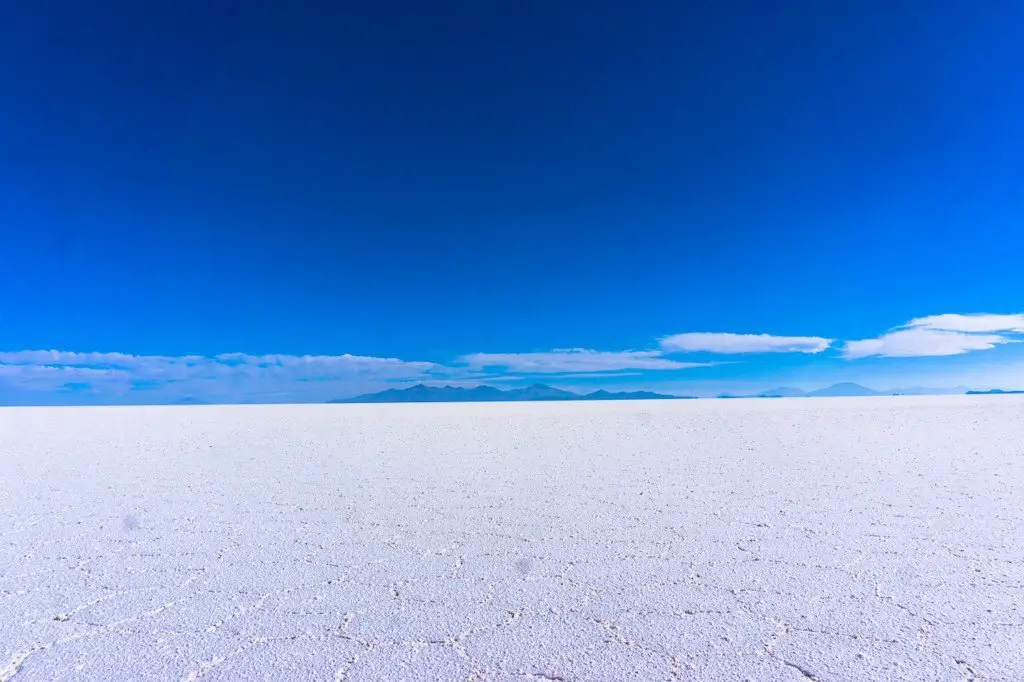
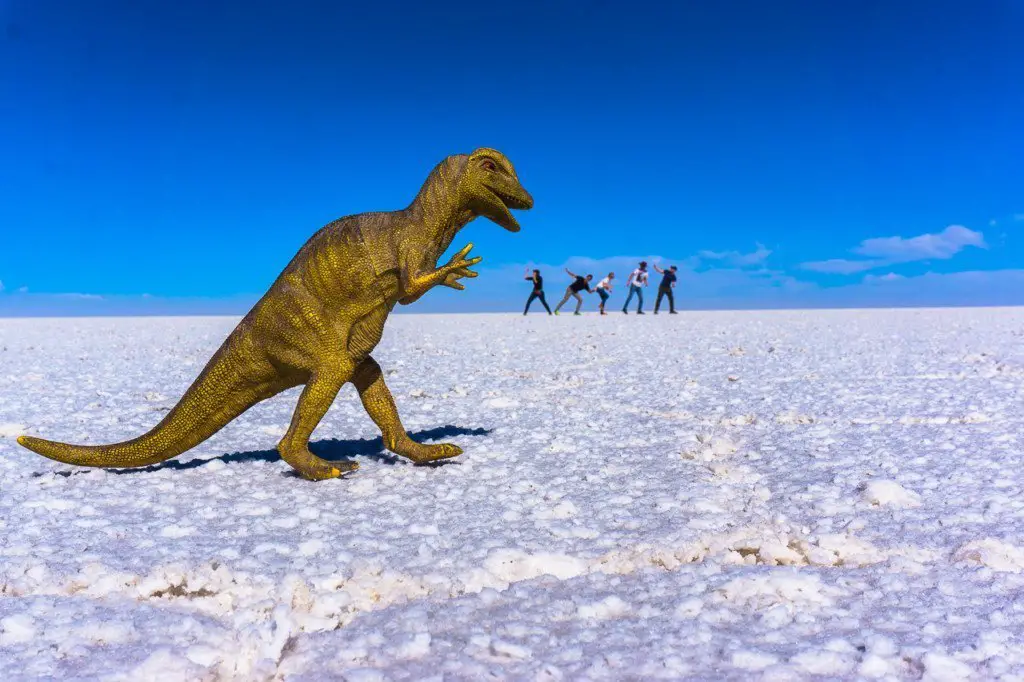
Reflective Salt Flats (Rainy season only, Jan-Apr)
In addition to the iconic all white photos of the Salt Flats, the other equally as famous photos are the impossibly reflective ground where a person looks like they are walking on water as the clouds are reflected below them. These photos are only possible during the rainy season (Dec-Apr) where the salt flats are actually flooded and a light layer of water covers the salt. It’s worth a visit back to the salt flats just for this reason alone!

Day 15-16: La Paz
Our salt flat tour ended at 5pm on the third day. We flew back that same evening to La Paz. The last day was spent walking around the highest city in the world (12,000m). We walked through the witches market and bought alpaca sweaters as La Paz is the cheapest place in South America to buy them. The cable cars that connect La Paz and El Alto offer fantastic panoramic views of the city and the Andes. I really enjoyed my time in La Paz and I think it’s a vastly underrated city.
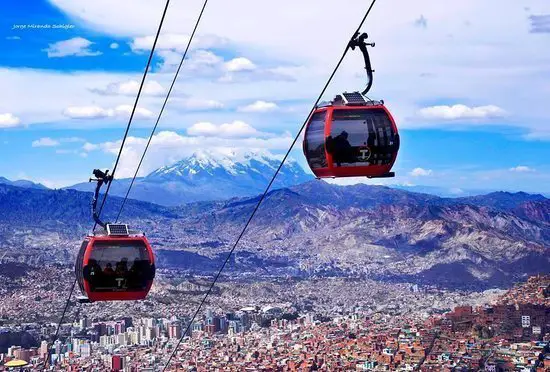
Day by Day Peru and Bolivia Itinerary
Day 1: Land in Lima, explore city and eat at various restaurants
Day 2: Sightseeing around Lima
Day 3: More sightseeing and eating
Day 4: Bus from Lima to Paracas, explore Paracas National Reserve
Day 5: Visit Ilha Ballestas in the morning, relax in the afternoon
Day 6: Day trip to Tacama winery and Huacachina Oasis
Day 7: Bus back to Lima, flight from Lima to Cusco, taxi from the airport to Ollantaytambo for the night
Day 8: Machu Picchu day
Day 9: Sacred Valley, ending in Cusco
Day 10: Explore Cusco
Day 11: Rainbow Mountain tour, overnight departure on Bolivia Hop bus
Day 12: Lake Titicaca, end in La Paz at night
Day 13: Early morning flight to Uyuni, being Salt Flat Tour
Day 14: Salt Flat Tour
Day 15: Salt Flat Tour, evening flight back to La Paz
Day 16: Explore La Paz
This itinerary might not be for everyone, and it certainly is not the way I would choose to travel if I had it my way. Nevertheless, sometimes you need to make do with the time you have. I met numerous travelers that were spending months traveling through South America, giving each destination the just time it deserved and drawing my envy. With that said, I never felt overly rushed with my trip. Although I definitely want to revisit both countries, I felt like I saw all the highlights in Peru and Bolivia.





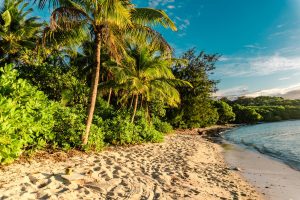


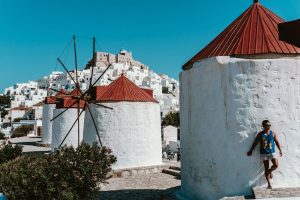

I am planning to visit Peru n Bolivia for 14 days next year solo. Thanks for this great itinerary! It was really helpful to plan and get excited
Thank you! Glad you liked the post!
This is great. This may seem a strange question but is there a lot of walking? I have MS so struggle with big treks due to strength and fatigue. I have backpacked India, SE Asia, and been OK as I took my time and did not do too much walking. This is the only thing worrying me about this trip, along with how altitude sickness may affect me with my MS.
Hi Christopher, I think you don’t need to do intense amounts of hiking if you don’t want to. Machu Picchu has great viewpoints not too far from entrance and there’s no need to hike up one of those mountains if you don’t want. As well with bolivia, the tour around the salt flats were very easy and no hiking required.
Hi Johnny,
Do you think February is a good month to follow through this itinerary. I have been planning to visit Peru and Bolivia with my wife in the February for our Anniversary next year.
Thanks
Shalabh
Hey shalabh, I think all months have its pros and cons and while Feb is the rainy season in the sacred valley, it doesn’t mean it is raining the entire time. However, I think you’ll be able to visit the salt flats with the reflective water which would be super cool!
So do you think we could visit Machu Picchu as well during February?
Yes of course!
I am planning a similar trip. I had got alot of information 🙂
Enjoy! You’ll love it.
Hi Johnny!
Thanks for the amazing post, I have been reading through it for the last hour. Just wanted to appreciate the effort you put. I am planning my trip in March next year, am finding varied opinions about travelling in march being the shoulder months. Would love to hear your opinion based on your interactions with the locals there.
*Also just wanted to correct a slight error, I believe the altitudes are in feet, 11000m would be beyond the Everest :P.
Hi Gulbagh, I think March should be okay as it is nearing on the dry season. However, I have heard stories of people going to Machu Picchu during the wet seasons and it was closed because of storms. Thanks for the spell check though 🙂
hello! what was the rough cost of your trip?
Hi pei, i would say roughly $1500 per person excluding international flights.
I am so relieved to stumble through your blog because we are planning on doing Peru and Bolivia in May 2020! A few questions I have (sorry for the questions lol)
-How many days do you think we need to acclimate to the altitude in Cusco before hiking Machu Picchu?
-We only have 8-9 days, how many days would you recommend we spend in Lima? (we aren’t doing the Paracas part of your tour, we are planning on going from Lima to Cusco)
-For the overnight bus from Cusco to La Paz, do you think we can use a large backpack and a carry on bag and those things will be okay (not stolen or taken off the bus)? Did anyone bring luggages with them such as small carry ons?
-overnight bus question again lol, did they wait for you if you were running behind from your day trips (i.e. day trip at Lake Titicaca and Copacabana). I’m just scared of being left behind with all my stuff in the bus. Also, can you leave your stuff in the bus during the day excursions and they won’t be stolen?
-Is there a toilet in the bus or does the driver stop for time to go to the bathroom, etc?
-last question I promise (for now lol), for the Salt Lake tour, is it possible to do it in a day (i.e. fly in the morning, buy a day tour on the spot at Uyuni, then fly back that same day back to La Paz)
Thanks so much in advance!!!
Hi Aggie, wow long comment 🙂
1. I didn’t stay in Cusco when i first got there. We went to Ollantaytambo straight from the airport which is lower in altitude so i ddin’t have issues. Had i stayed in Cusco from the getgo, I would have been in bad shape because it really affected me (didn’t take any tablets).
2. I would say 3 days is a healthy amount of time for it but with your timeline maybe less.
3. Yes wil be fine. Nothing wlil be stolen
4. You will be back on time because the day trips are organized by the bus company. But otherwise, would definitely not be late for anything as they will leave.
5. there is a toilet on the bus 🙂
6. I think you can do in the day as the flights leave at 6am and only take 1 hr. You can see the salt flats during the day and fly back, but you won’t be able to see anythign else besides the salt flats. Hope this helps!
Hi Johnny,
I found your 2-week itinerary to Peru and Bolivia. Your photos are stunning. I am a solo traveler and I am trying to stitch together several small group tours to Machu Picchu, Sacred Valley, Rainbow Mountain, Lake Titicaca and the Salt Flats. You have a side trip from Lima to Paracas. I assume you were on Peru Hop for that trip. I had not considered going to Pacaras.. I feel like the only way to work it in my itinerary is to do 2 day/1 night hike in Machc Picchu rather than 4 day 3 nights hike. How much did you like the Paracas area vs Machu Picchu?
I appreciate your ideas for me.
Thank you so much and you have a beautiful blog. Best, Connie
Hi Connie! I did not use Peru hop from Lima to Paracas. There’s no need really as there are regular buses that make the journey but of course if you are with peru hop it will be more fun as you’ll meet more people. I never did the 4 day/3 night hike to Machu Picchu so I can’t comment on that but I really wanted to visit Paracas for some reason and I wasn’t keen on a multi-day hike so that’s why i went with it. I think if you’re set on doing the Inca trail, definitley go for it. Paracas is a bit of a sleepier place but you can also visit Hucachina which is quite cool. Hope that helps!
Thank you Johnny! I guess I need decide on hiking for several days. I appreciate your help!
Hi Johnny,
Did you rent a car in Peru and/or Bolivia? If not, how did you mostly get around to different parts of the countries?
Thanks!
Hi Haley! I did not rent a car, and I’m not sure if you could even take a car rented in Peru into Bolivia. I took buses from Lima to Paracas area, and flew from lima to Cusco. Then from Cusco to La Paz, I took a bus. i also tok a flight from La paz to Uyuni for the salt flats. So ya mostly buses and two flights!
Hi Johnny,
Thanks for sharing your itinerary, it’s been a huge help. Question- Did you book your flights from La Paz to Uyuni and back ahead of time?
I’m looking to fly into Peru and do a similar itinerary. I’m planning on flying to cusco, then flying to la paz instead of the bus, flying to Uyuni and back, and then back to Lima. I’m wondering if I need to book those ahead of time or if it’s better to do it there. I only have about 14 days so there’s some flexibility, but not much. Any recommended airlines? Thanks!
Hi Mallory! Yes I think you can definitely fly the entire way! From LA Paz to uyuni, amaszonas is the main airline I took there and back. I think latam also flies direct from cusco to LA Paz. I think if you can, book it ahead of time because you just never know and you don’t want to be stuck with no flights on a tight schedule!
This is JUST what I was looking for! Thanks for such a helpful writeup and confirming that 2 weeks is enough for this trip!
Hi Bruce! Obviously, I would prefer to have more time if I could but you gotta make due with what you have sometimes! Enjoy your trip and glad to be of help
Hi Johnny,
I am so glad I came across this vlog! It is so helpful!
My boyfriend and I are planning a trip at the end of September. I was wondering, do you advise to buy flights within south America in advanced or once we are there? I am trying to plan ahead as much as possible.
Also, was the sea temperature warm in enough to enjoy swimming in Paracas when you visited?
Thanks Ana! I would def recommend to buy the flights beforehand because it’s good to hav eit all out of the way and it’s unlikely you’ll score any significant deals just being in the country.
And for Paracas, it is definitely not warm enough to swim during the winter but I think it warms up enough in the summer months where people swim. So for the end of Sep, I would definitely not be swimming!
Hi Johnny, thanks for your awesome blog! How did you book the sacred valley/Pisac tour from Ollantaytambo ending in Cusco? I am trying to follow a similar itinerary. Any help will be great!
Hi kaushal, I booked the drive with my guesthouse in ollantaytambo as we were staying there for the machu picchu hike. Should be quite easy to find a service however!
Hey Johnny!
My husband and I are planning to do a trip to Bolivia and Peru next year. I have read all your posts on these two places and I can’t be more excited! Just wondering when is a good time to visit according to your experiences. We are actually thinking of going in early October. By good, I meant ideal weather conditions such that we will not need to layer up too excessively while doing the hikes etc.. I saw that you did this trip in early September. Would you recommend we do the same as well? This is our first time to South America. Hence, would really appreciate your advice/ recommendation. Thank you!
Hi Vanessa! I think early October is a great time to go. No matter what, the salt flat tour will always be cold at night. When you’re that high up in elevation, the temperature will always drop dramatically. October will probably be slightly warmer than September, but is still in the dry season. Enjoy your trip!
Hi Johnny,
Curious as to what your budget was for all this?
Thanks
Erika
Hey Erika, it’s tough for me to recall everything but here are some costs I know to be true.
Lima to Cusco: $90 flight
Machu Picchu entry: $45
Machu Picchu Train+Bus: $165
Salt Flat tour: $200
La Paz to Uyuni Flights: $150 roundtrip
That is $650 right there just in transportation and entrance fees. We stayed at Airbnbs most of the time, and splurged on a nice hotel in Paracas. We also ate at nicer places in Lima. All in all, I’d guess we spent about $2k per person (was me and my GF) for the entire trip (excluding flights to and from Peru). You could easily bring this down to $1.5k if you sticked to less fancy places and stayed in hostels depending on your style!
What tours did you go with on your trip?
Hi Daniel, the only organized tour I did was the salt flats in Bolivia. That one is mandatory (can’t go on your own for that one). The other days were mostly activities I booked for a day, like sand dunes in huacachina, and hiring a driver to drive us around the sacred valley
I’m doing a 6 month around the world trip through every continent except Antarctica. I started in South America (I’m currently in Chile) and I followed your route from Peru to Bolivia, ending my salt flats tour in Chile. I just wanted to let you know that your blog was extremely helpful when planning this portion of my trip- from the bus routes, to getting my Bolivian visa, to what to expect in the salt flats. I really appreciate the time and information that you’ve shared in your blog. Keep up the excellent work!
Thanks Kate! Glad to have been helpful and enjoy the rest of your big trip! Super jealous.
Hi. Nice blog!
Did you visit in Southern hemisphere Summer(Dec.-Jan.)? I have heard that rains can be a problem on the MP route from December to February. The same for Bolivia from December.
However, your pics are sunny and hot! Would love to hear from you on this dreaded rain (I am based in Japan where it can can rain anytime).
A note on the heights. Surely the altitude is in ft. and not meters? 12000m would definitely be on another planet 😉
Cheers
V
Hi there, I went in September during the dry season. It was definitely mostly dry. I have heard the same things about the rainy season thay you have. I met travelers that had been to MP before and they couldn’t go because of rains during that time. But just like any wet season anywhere, it’s always variable. Also the uyuni salt flats take on a whole different form during the rainy season where it’s completely reflective. Thay alone would make me want to visit the region in the rainy season!
Hi Johnny! Thanks so much for posting your itinerary – it’s been so helpful even going through the comments! 🙂 Just a quick question for you, did you travel with luggage or a big backpack? I’m thinking of doing a similar trip as you with a 55L pack.
Thanks,
Terenece
Hi Terence, I prefer to always travel with a backpack so I am biased :). Honestly, because I am on the go so much, I think a backpack is the way to go, especially when you’re traveling through the salt flats!
Hi Johnny ????. If I can ask, what all did you bring? It sounds like you packed light. Did you just have one change of clothes or like a few? And how often were you able to shower or wash clothes? Guess I’m just wondering what all I should bring lol. Thanks ????
Hi Leon, I generally pack light in all my travels. I had enough clothes to last me the two weeks 🙂 and no i did not wash my clothes at any time. I did shower frequently however!
Hello Johnny, thanks for posting your itinerary and experience in Peru and Bolivia! It is helping me a lot in booking my trip this coming August.
Did you book all of your tours (like Machu Pichu, Rainbow Mountain, Salar etc.) in advance of you going to Peru and Bolivia? If so, which tour companies did you use?
Do you have any hotel/hostel recommendations in all the locations you visited? Im basically following your itinerary but with 12 extra days.
Many thanks in advance,
Hi mark, I didn’t book a tour for Machu Picchu but did do so for the Rainbow Mountain and Salar de Uyuni. I honestly do NOT recommend booking a tour beforehand for rainbow mountain. I paid at least 2x the going rate. Literally, every shop and their mothers will sell you the rainbow mountain tour in Cusco so there is no point to prebook this as you’ll pay much more. The going rate on the street was around 100 soles which is a great deal in my mind.
As for the Salar De Uyuni, I booked a tour with Andes Salt Expeditions which you can read about on my detaied salt flats post. Since you have less time, you should probably book this before hand so they pick you up from the airport and straight to the tour. I stayed at Airbnb’s in Cusco so can’t recommend any hostels unfortunately!
Hi Johnny,
Thanks for the great sharing! May I know how did you leave La Paz in the end of the journey? I was thinking that somehow I would need to head back to Lima from there…
Also, was there enough time for acclimatizing yourself to the altitude from macchu picchu to rainbow mountain?
Hi Hoi, I flew home back to the states from La Paz but I know there are direct flights to Lima nowadays (about $250 one way). If that’s out of the budget, I would take the bus back to Copacabana, then to Puno. From Puno, there are regular buses that will go to Lima and this whole trip should cost no more than $50.
As for acclimation, Rainbow Mountain is very high but we were only at that altitude for a few minutes so it wasn’t that bad. I was also in Cusco for a few days before the Rainbow Mountain so the increase in altitude didn’t affect me as badly. That’s why I always recommend NOT to do the Rainbow Mountain trip immediately upon arriving in Cusco!
Thanks so much Johnny! Super appreciate it!
No problem! Glad it helped.
Thanks Johnny- so glad to have seen your post- I didn’t know where to start when planning our trip- now I’ve started and finished!!!!
Awesome! Glad you found the post useful!
Hi Johnny, I’m so stoked that you posted this! You wouldn’t believe it but I’ve been trying to plan the exact same itinerary but have been feeling wearing, wondering if it’s too much in too short of a time. Your post is just what I needed to read!
Btw do you happen to remember how much your flight from La Paz to Uyuni was?
Hi Ericka, glad to hear it! The flights were fixed when I was there at about $75 one way on Amaszonas. Enjoy your trip!
Hi,
Thank you for this! Exactly what we were looking for. Can I ask regarding local flights-did you book before you left or is it ok to book when you are there? Planning to do a pretty similar trip to this in January.
Hey Amy, I think you can book local flights when you’re there no problem but if you can, no reason not to book them before hand. The Amazonas flight from LA Paz to uyuni was definitely no where near capacity so I think that one you can easily wait to book last minute!
Hi Johnny
I am planning a similar trip at the moment and your itinerary looks awesome! Can I ask what time of year did you go?
Many thanks
Laura
Thanks Laura! We went the first two weeks of September!
Very helpful! Thanks for the post Johnny, I am looking to visit Peru and Bolivia together as well. I have three weeks off however (more holiday in Europe). What would you change/add if you had another week on your itinerary?
Hi Anna, that’s a great question! I think in a perfect world, I would have loved to have another week. I would have done the following:
– definitely spent another night in Lake Titicaca, probably in Copacabana.
– Spend a night in Huacachina instead of a day trip
– Visit Arequipa, spend 3-4 nights
– Another night in Cusco because there was just so much more to discover in that town